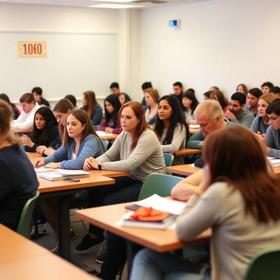- Georgia Military College was established in 1879 by act of the Georgia General Assembly "-to educate young men and women from the Middle Georgia area in an environment which fosters the qualities of good citizenship." Georgia Military College is a public-independent educational institution, comprised of a junior college and a separate preparatory school (grades 6-12), whose mission and purpose is to produce educated citizens by providing junior college students with a liberal arts based two-year undergraduate curriculum, by providing selected college students with ROTC training, and by providing preparatory school students an inclusive college preparatory curriculum that includes a military training component--all in an environment conducive to the holistic development of the intellect and character of its students.
School Highlights
Georgia Military College-Augusta Campus serves 1,236 students (60% of students are full-time).
The college's student-teacher ratio of 25:1 is higher than the state community college average of 18:1.
Minority enrollment is 62% of the student body (majority Black), which is more than the state average of 61%.
Quick Facts (2026)
- Enrollment: 1,236 students
- Student-teacher ratio: 25:1
- Minority enrollment: 62%
- Source: Integrated Postsecondary Education Data System (IPEDS)
Top Rankings
Georgia Military College-Augusta Campus ranks among the top 20% of public schools in Georgia for:
Category
Attribute
Diversity
School Overview
The teacher population of 50 teachers has stayed relatively flat over five years.
Georgia Military College-Augusta Campus
(GA) Community College Avg.
Carnegie Classification
Associate of Arts Colleges
Associates--Public Rural-serving Medium
Institution Level
Less than 2 yrs
At least 2 but less than 4 years
Institution Control
Public
Public
Total Faculty
50 staff
209 staff
School Calendar
Student Body
The student population of Georgia Military College-Augusta Campus has stayed relatively flat over five years.
The student-teacher ratio of 25:1 has stayed the same over five years.
The Georgia Military College-Augusta Campus diversity score of 0.70 is less than the state average of 0.71. The school's diversity has stayed relatively flat over five years.
Total Enrollment
1,236 students
2,604 students
Student-Teacher Ratio
25:1
18:1
# Full-Time Students
737 students
882 students
# Part-Time Students
499 students
1,722 students
# Enrollment Undergraduate
n/a
299 students
# Full-Time Undergraduate Students
1,236 students
929 students
# Full-Time Graduate Students
n/a
87 students
# Part-Time Undergraduate Students
n/a
1,848 students
# Part-Time Graduate Students
n/a
53 students
Total Dormitory Capacity
n/a
654 students
% American Indian/Alaskan
1%
n/a
% Asian
2%
4%
% Hispanic
3%
10%
% Black
36%
35%
% White
38%
39%
% Hawaiian
n/a
1%
% Two or more races
2%
3%
% Non Resident races
n/a
1%
% Unknown races
17%
7%
Diversity Score
0.70
0.71
College Completion Rate (Students who graduate in less than 4 years)
16%
31%
College Completion Rate (Students who graduate in 4 years or more than 4 years)
n/a
24%
Average Graduate Earnings (10 Years)
$35,000
$30,600
Tuition and Acceptance Rate
% Students Receiving Some Financial Aid
n/a
93%
Median Debt for Graduates
$9,187
$9,187
Median Debt for Dropouts
$3,500
$3,667
Acceptance Rate
n/a
75%
SAT Reading
n/a
465
SAT Math
n/a
450
SAT Writing
n/a
465
ACT Composite
n/a
18
ACT English
n/a
18
ACT Math
n/a
18
ACT Writing
n/a
7
Source: 2023 (or latest year available) Integrated Postsecondary Education Data System (IPEDS)
Frequently Asked Questions
What schools are Georgia Military College-Augusta Campus often compared to?
Georgia Military College-Augusta Campusis often viewed alongside schools like Augusta Technical College by visitors of our site.
What is Georgia Military College-Augusta Campus's ranking?
Georgia Military College-Augusta Campus ranks among the top 20% of community college in Georgia for: Diversity in US community colleges.
Recent Articles

Part-Time vs. Full-Time Enrollment in 2025: Which Is Better?
Explore part-time vs. full-time enrollment in 2025, comparing costs, flexibility, outcomes, and goals to help students choose the right path.

How Community Colleges Use AI Tools to Support Student Success
Explore how community colleges are using AI tools in 2025 to improve advising, learning, retention, and student success.

Nontraditional Student’s Guide to Community College 2025
Comprehensive guide for nontraditional students at community college with updated tuition, support, careers, and success strategies for 2025.







